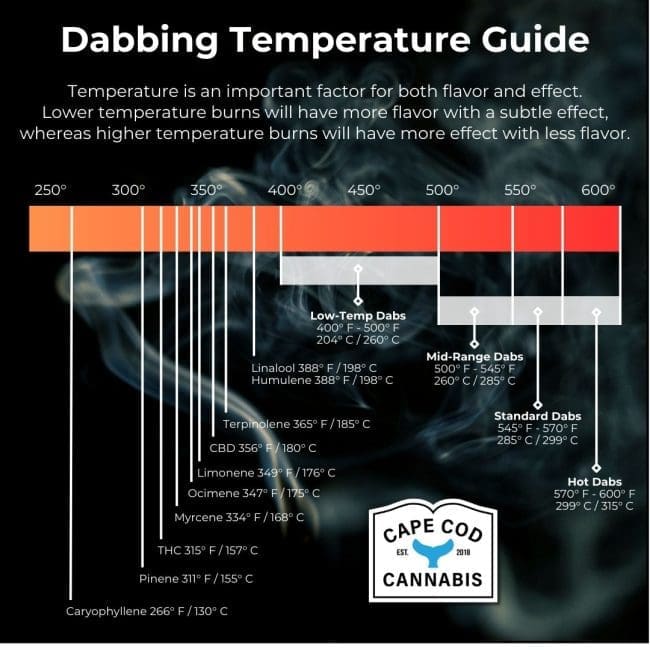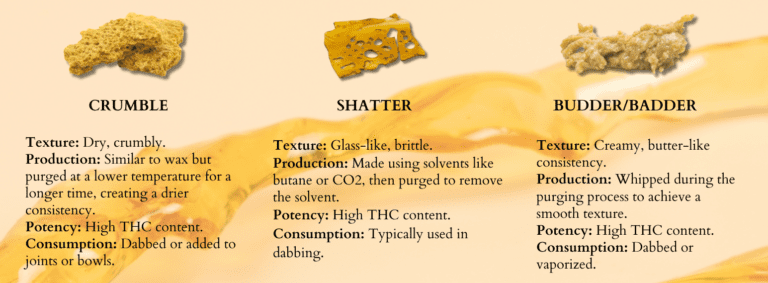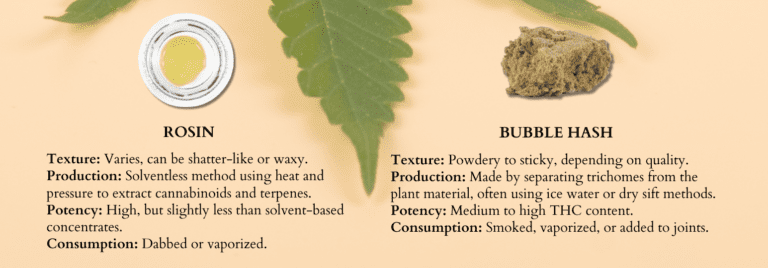
In the cannabis industry, concentrates are potent extracts of the cannabis plant that contain high levels of cannabinoids like THC or CBD. There are several types of cannabis concentrates, each with unique properties and methods of consumption. Here are some of the most common types:
1. Shatter
Texture: Glass-like, brittle.
Production: Made using solvents like butane or CO2, then purged to remove the solvent.
Potency: High THC content.
Consumption: Typically used in dabbing.
2. Wax
Texture: Soft, waxy, can be crumbly or sticky.
Production: Similar to shatter but agitated during the extraction process, resulting in a softer consistency.
Potency: High THC content.
Consumption: Dabbed, vaporized, or added to joints.
3. Budder/Badder
Texture: Creamy, butter-like consistency.
Production: Whipped during the purging process to achieve a smooth texture.
Potency: High THC content.
Consumption: Dabbed or vaporized.
4. Crumble
Texture: Dry, crumbly.
Production: Similar to wax but purged at a lower temperature for a longer time, creating a drier consistency.
Potency: High THC content.
Consumption: Dabbed or added to joints or bowls.
5. Live Resin
Texture: Varies from sauce-like to waxy.
Production: Made from fresh, flash-frozen cannabis plants, preserving terpenes and flavors.
Potency: High THC content with rich terpene profile.
Consumption: Dabbed or vaporized.
6. Rosin
Texture: Varies, can be shatter-like or waxy.
Production: Solventless method using heat and pressure to extract cannabinoids and terpenes.
Potency: High, but slightly less than solvent-based concentrates.
Consumption: Dabbed or vaporized.



7. Hash (Bubble Hash)
Texture: Powdery to sticky, depending on quality.
Production: Made by separating trichomes from the plant material, often using ice water or dry sift methods.
Potency: Medium to high THC content.
Consumption: Smoked, vaporized, or added to joints.
8. Distillate
Texture: Thick, clear, viscous oil.
Production: Refined through distillation to isolate specific cannabinoids like THC or CBD.
Potency: Extremely high, often upwards of 90% THC.
Consumption: Used in vape cartridges, edibles, or dabbed.
9. Crystalline (THC-A Crystals)
Texture: Crystal-like, powdery.
Production: Through a process of isolation and refinement to create pure THC-A crystals.
Potency: Up to 99% THC-A.
Consumption: Dabbed or added to other cannabis products.
10. Sauce
Texture: Sticky, viscous, with visible crystalline structures.
Production: Extracted using hydrocarbons, resulting in a mix of high-terpene extract and THC-A crystals.
Potency: High THC content with a robust terpene profile.
Consumption: Dabbed or vaporized.
Each type of concentrate offers a different experience, from the flavor profile to the intensity of effects, and is chosen based on personal preference and intended use.
